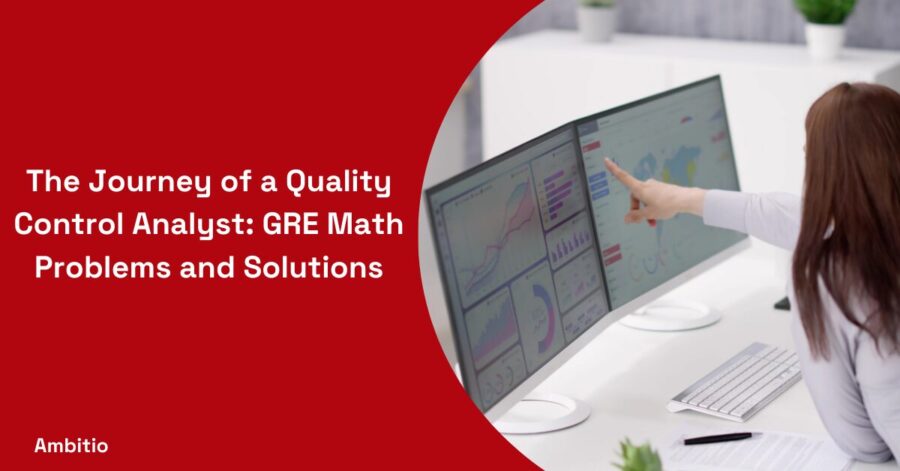14 December 2024
5 minutes read
The Journey of a Quality Control Analyst: GRE Math Problems and Solutions

Introduction
Quality control analysts are the silent heroes working diligently behind the scenes to ensure that products meet the highest standards of quality. Their role is critical in various industries, ranging from manufacturing to healthcare.
In this comprehensive blog, we will delve into the fascinating world of quality control analysts, focusing on their role and how they tackle GRE math problems related to measurements and quality assessment.
Understanding the Role of a Quality Control Analyst
The Crucial Role of Quality Control Analysts
Quality control analysts are the linchpins of quality assurance in industries that demand precision and consistency. Their primary responsibility is to collect and analyze data to ensure that products or processes meet specific quality standards. This involves meticulous measurement, data interpretation, and problem-solving.
A Day in the Life of a Quality Control Analyst
To grasp the significance of their role, it’s essential to walk in the shoes of a quality control analyst. From collecting samples to conducting tests and analyzing results, their daily routine is filled with tasks that demand precision and attention to detail.
Solving GRE Math Problems as a Quality Control Analyst
Mathematical Foundations for Quality Control
Mathematics serves as the cornerstone of quality control. Analysts rely on mathematical concepts to assess product quality, calculate averages, determine acceptable ranges, and identify deviations. In this section, we’ll explore the mathematical foundations that underpin their work.
Example GRE Math Problems
To understand how GRE math problems relate to the work of quality control analysts, we’ll delve into some real-life examples. These problems often involve concepts like averages, measurements, and statistical analysis, mirroring the challenges analysts encounter in their professional journey.
The Importance of Precision in Quality Control
Precision and Accuracy in Measurements
Precision and accuracy are paramount in quality control. Analysts must ensure that measurements are not only precise but also accurate, as even the smallest discrepancies can lead to significant quality issues. We’ll explore the methods and tools used to achieve precision in measurements.
The Role of Statistics in Quality Control
Statistics is an invaluable tool for quality control analysts. They use statistical methods to analyze data, assess the distribution of measurements, and make informed decisions about product quality. We’ll delve into how statistics plays a crucial role in their work.
Preparing for GRE Math Problems in Your Journey
Strengthening Mathematical Proficiency
For quality control analysts, mastering mathematics is a continuous journey. We’ll discuss strategies to strengthen mathematical proficiency, including practicing with GRE-specific study materials, reviewing fundamental concepts, and seeking additional resources.
Practical Problem-Solving Skills
GRE math problems not only test mathematical knowledge but also problem-solving skills. Quality control analysts must apply their mathematical expertise to real-world situations, and we’ll provide insights into developing these critical skills.
Expert Solutions to GRE Math Problems
Quality control analysts encounter GRE math problems that mirror real-world scenarios they face in their profession. In this section, we’ll provide detailed, step-by-step solutions to some common GRE math problems related to measurements and quality assessment.
These solutions will not only help you understand the math behind the problems but also equip you with problem-solving techniques applicable to your work as a quality control analyst.
Problem 1: Calculating the Average Measurement
Problem: A quality control analyst collected 200 measurements, and the average measurement is 49.5 centimeters. Calculate the total sum of all measurements.
Solution: To find the total sum of all measurements, you can use the formula:
Total Sum = Average Measurement × Number of Measurements
In this case, the average measurement is 49.5 centimeters, and the number of measurements is 200. Therefore:
Total Sum = 49.5 cm × 200 = 9900 cm
So, the total sum of all measurements is 9900 centimeters.
Problem 2: Determining the Range of Measurements
Problem: A quality control analyst collected 200 measurements, and the range of the measurements is 17 centimeters. If the smallest measurement is 32.5 centimeters, what is the largest measurement?
Solution: The range of measurements is the difference between the largest and smallest measurements. Given that the smallest measurement is 32.5 centimeters, and the range is 17 centimeters, you can find the largest measurement as follows:
Largest Measurement = Smallest Measurement + Range
Largest Measurement = 32.5 cm + 17 cm = 49.5 cm
So, the largest measurement is 49.5 centimeters.
Problem 3: Assessing Measurement Deviation
Problem: A quality control analyst collected 100 measurements of a product’s length. The average measurement is 50 centimeters, and the acceptable range is ±2 centimeters. How many measurements fall outside the acceptable range?
Solution: To determine how many measurements fall outside the acceptable range, you can calculate the deviations from the average measurement and then compare them to the acceptable range.
Deviation = |Measurement – Average Measurement|
In this case, the acceptable range is ±2 centimeters, so any measurement that deviates more than 2 centimeters from the average is outside the acceptable range. Calculate the deviations for each measurement and count how many exceed 2 centimeters.
Problem 4: Finding the Median Measurement
Problem: A quality control analyst collected 50 measurements of a product’s weight. Arrange the measurements in ascending order and find the median measurement.
Solution: To find the median measurement, first arrange the measurements in ascending order. Once they are sorted, the median will be the middle measurement.
Problem 5: Analyzing Measurement Trends
Problem: A quality control analyst collected measurements of a product’s temperature over five consecutive days: 68°F, 70°F, 72°F, 74°F, and 76°F. Calculate the average temperature and assess whether there is a trend in the data.
Solution: To calculate the average temperature, sum all the temperatures and then divide by the number of measurements (in this case, 5). This will give you the average temperature. To assess the trend, observe if the temperatures are consistently increasing, decreasing, or staying relatively constant over the five days.
Conclusion
Quality control analysts are the unsung heroes who ensure that the products we use every day meet rigorous quality standards. Their journey involves precision, mathematics, and problem-solving, including tackling GRE math problems.
As we explored the various facets of their role and provided expert solutions to math problems, we gained a deeper appreciation for their dedication and the vital role they play in diverse industries.
FAQs
Q1: What is the role of a quality control analyst?
A quality control analyst is responsible for ensuring that products or processes meet specific quality standards. They collect and analyze data, perform measurements, and identify any deviations from the desired quality parameters.
Q2: What does “GRE” stand for in this context?
In this context, “GRE” refers to Graduate Record Examination, a standardized test often required for admission to graduate programs. Quality control analysts may encounter GRE math problems as part of their educational journey.
Q3: How can GRE math problems relate to the work of a quality control analyst?
GRE math problems often involve mathematical concepts related to measurements, averages, and ranges. Quality control analysts deal with similar mathematical concepts when assessing product quality and consistency.
Q4: Can you provide an example of a GRE math problem related to quality control?
Certainly! Here’s an example: “A quality control analyst collected 200 measurements, and the average measurement is 49.5 centimeters. What is the range of the 200 measurements?”
Q5: What skills are important for a quality control analyst to excel in their role?
Quality control analysts should possess strong analytical and problem-solving skills, attention to detail, proficiency in mathematics, and the ability to interpret data accurately.
Q6: How can I prepare for GRE math problems as a quality control analyst?
To excel in solving GRE math problems, consider practicing with GRE-specific study materials and practice questions. Additionally, brushing up on your mathematical skills and understanding measurement concepts will be beneficial.

You can study at top universities worldwide!
Get expert tips and tricks to get into top universities with a free expert session.
Book Your Free 30-Minute Session Now! Book a call now




























